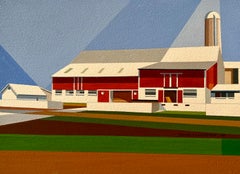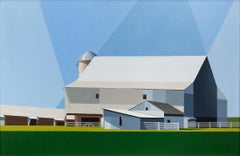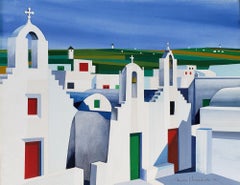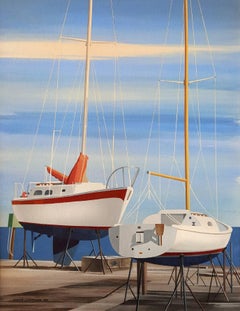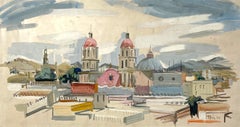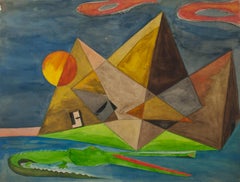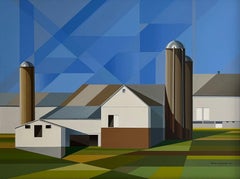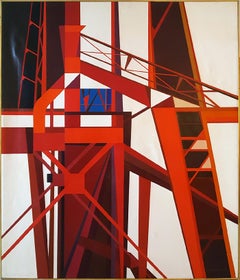Edmund Lewandowski Art
American, 1914-1998
Regarded as a leading American precisionist and exemplary arts educator, Edmund D. Lewandowski once explained that his “overwhelming desire . . . through the years has been to record the beauty of man-made objects and energy of American industry,” a goal he successfully achieved in a career that spanned five decades and numerous locations, including the American Midwest, South, and New England. Born to Polish parents in Milwaukee, Wisconsin, Lewandowski attended the Layton School of Art, studying under regionalist artist Gerrit Sinclair. Inspired by Sinclair’s modern style and urban subjects, Lewandowski’s early paintings reflect a similar approach that would later evolve to industrial themes executed in a hard-edged precisionist manner. His most well-known subjects include chemical plants, shipyards, factories, farms, and oil rigs.
Following graduation, Lewandowski worked as a public school teacher and commercial artist while pursuing his painting. His career took a significant step forward when, in 1936, his work caught the eye of the progressive art dealer Edith Halpert, who offered him representation at her celebrated Downtown Gallery in New York City. A key figure in modern art, Halpert encouraged Lewandowski to experiment with Precisionism and to remain in Milwaukee. In 1937, Lewandowski met Charles Sheeler, considered a leader in the American Precisionist movement, whose style would most significantly influence the younger artist’s career. Through his association with the Downtown Gallery and the work he executed for the Federal Art Project between 1936 and 1939, Lewandowski attracted important critical notice and was included in exhibitions at such notable institutions as the Metropolitan Museum of Art, Museum of Modern Art (Magic Realism exhibition), and Art Institute of Chicago during the 1940s alone. At the Downtown Gallery, he exhibited alongside other artists such as Charles Demuth, Georgia O'Keeffe, Ralston Crawford, George Ault, and Niles Spencer.
Following military service as an Air Force mapmaker and camouflage artist from 1942–1946, Lewandowski joined the faculty of his alma mater, the Layton School of Art, in 1947. From that time on, he divided his time between creating art and teaching another generation of aspiring artists. His teaching career took him to institutions throughout the United States, including Florida State University. Following his tenure at Florida State, Lewandowski returned to Layton as its director, remaining until 1972. Throughout these years, the artist would create and exhibit works on paper and canvas, as well as execute commissioned large-scale mosaic murals. In 1973, Lewandowski joined the faculty at Winthrop University in Rock Hill, South Carolina, where he would serve as the art department chair until his retirement in 1984.
Edmund Lewandowski’s art showcases an exacting technical skill honed in his early training and advanced by his relationship with Sheeler. His ultrarealistic works painted in watercolor, gouache, or oil range from early farmscapes to industrial scenes and marine subjects, a variety that reflects the artist’s constant quest for aesthetic evolution. Today, Lewandowski’s work can be seen at prestigious national museums.to
2
4
4
3
2
1
1
1
Amish Farmscape #2 Study
By Edmund Lewandowski
Located in Los Angeles, CA
Amish Farmscape #2, 1982, gouache, 9 x 12 inches, signed and dated lower right, label verso: “Artist-E. Lewandowski, Title- Amish Farmscape #2 STUDY, Date- 1982, Size- 9”x 12”, Medium- Gouache”, Provenance: Franklin Riehlman, Riverdale, New York, to Herman Zerweck, Ann Arbor, Michigan, 1996; Provenance: Richard Hartman, Gallery of Wisconsin, Wisconsin
Edmund Lewandowski was among the best of the second-generation Precisionists. He is credited with extending Precisionism to the Midwest and successfully evolving the style into the 1980s and 1990s with his Neo Immaculate works.
Lewandowski was born and raised in Milwaukee, Wisconsin, and studied at the Layton School of Art with Garrett Sinclair...
Category
1980s American Modern Edmund Lewandowski Art
Materials
Paper, Watercolor, Gouache
Amish Farmscape #1
By Edmund Lewandowski
Located in New York, NY
This painting is the first in Edmund Lewandowski’s Amish Farmscape series, believed to have been created for his solo exhibition at the Sid Deutsch Gallery in New York City. He began...
Category
1980s Edmund Lewandowski Art
Materials
Canvas, Oil
Mykonos Church Landscape
By Edmund Lewandowski
Located in Miami, FL
A vibrant example of the artist's precisionist style where a tight semi-abstract geometric composition is inspired by architecture and is reduced to simplified geometric shapes with...
Category
1960s Abstract Geometric Edmund Lewandowski Art
Materials
Gouache, Board
$11,200 Sale Price
20% Off
Sail Boats
By Edmund Lewandowski
Located in Miami, FL
A precise and exact rendering and meticulous spacial arrangement are on full display in Lewandowski's this later work.
The work looks better in person. The artwork is in pristine co...
Category
1990s Photorealist Edmund Lewandowski Art
Materials
Watercolor, Gouache
$24,000 Sale Price
29% Off
Related Items
A Charming 1940s Watercolor of Mexico w/ Cathedral and Rooftops by Rudolph Pen
Located in Chicago, IL
A Charming 1940s Watercolor of Mexico with Cathedral and Rooftops by Noted Chicago Artist, Rudolph T. Pen. Most likely completed during the artist's trip to Mexico in 1944 after rec...
Category
1940s American Modern Edmund Lewandowski Art
Materials
Paper, Watercolor, Gouache
$1,200
H 12 in W 22.5 in D 0.13 in
Untitled (Surrealist rendering of Pyramids at Giza with alligator)
By Beni E. Kosh
Located in Fairlawn, OH
Untitled (Surrealist rendering of Pyramids at Giza with alligator)
watecolor and gouache on paper, 1960
Unsigned
Beni Kosh estate stamp No. 717 verso, unsigned.
(see photo)
Condition: Minor condition issues
minor folds
Not objectionable
Image/Sheet size: 18 1/4 x 24 inches
Provenance:
Estate of the Artist
Bingham Vance, Shaker Heights...
Category
1960s Surrealist Edmund Lewandowski Art
Materials
Watercolor, Gouache
$2,000
H 18.25 in W 24 in
Circle of Duncan Grant, Bloomsbury set, Rye Windmill by the river
By Duncan Grant
Located in Harkstead, GB
This idyllic scene with the reflections in the water is of Rye Windmill in East Sussex, an area which was frequented by Duncan Grant and his Bloomsbury friends and associates.
Circl...
Category
Early 20th Century English School Edmund Lewandowski Art
Materials
Canvas, Oil
$829 Sale Price
20% Off
H 14 in W 10 in D 2 in
Original Painting New Yorker Mag Cover proposal. Army Wedding American Scene WPA
By Antonio Petruccelli
Located in New York, NY
Original Painting New Yorker Mag Cover proposal. Army Wedding American Scene WPA
Antonio Petruccelli (1907 – 1994)
Army Wedding
New Yorker cover proposal, c. 1939
11 1/2 X 8 inches ...
Category
1930s American Realist Edmund Lewandowski Art
Materials
Gouache, Board
Houses in Zoar, Ohio Landscape, Early 20th Century Cleveland School
By August F. Biehle
Located in Beachwood, OH
August Frederick Biehle (1885-1979)
Houses in Zoar, c. 1921
Gouache, litho crayon, colored pencil and graphite on paper
Signed lower right
14 x 19 inches
20.25 x 25.25 inches, framed...
Category
1920s American Modern Edmund Lewandowski Art
Materials
Gouache, Graphite, Color Pencil, Crayon
$7,250
H 20.25 in W 20.25 in
French Fauvist Gouache of Sailing Boats in Port Under a Setting Sun.
Located in Cotignac, FR
Watercolour and gouache on paper of sailing boats at a quay side. The painting is signed bottom right but as yet undeciphered and dated 1945. Presented in a patinated wood custom fra...
Category
Mid-20th Century Expressionist Edmund Lewandowski Art
Materials
Watercolor, Gouache, Paper
$756 Sale Price
20% Off
H 20.48 in W 22.84 in D 0.6 in
Clinton Hill, (Nude #2), 1950, drawing, figure/abstraction
By Clinton Hill
Located in New York, NY
Clinton Hill (1922-2003), created quintessential mid-century images, but figures are unusual in his work. This is from a very early period. From 1949 to 1951 he attended the Brooklyn...
Category
Mid-20th Century American Modern Edmund Lewandowski Art
Materials
Gouache
Rue Étienne Marcel, Paris, France
By Henri Grenier
Located in Atlanta, GA
One of my favorite French Fauvist painters, Henri Grenier (1882 - 1940), masterfully captures the energy of the turn-of-the-century Boulevard Saint-Germain in this exciting work on p...
Category
Early 20th Century Fauvist Edmund Lewandowski Art
Materials
Gouache
Captivated - Art Deco, Modern, Abstract, Colorful, Minimalism, Invest, Bold, Joy
By Karnish Art
Located in Pretoria, Gauteng
Title: Captivated
Art Deco, Modern, Abstract, Colorful, Minimalism, Invest, Bold, Joy
This series connects to that around as well as that within.
Captivated takes the viewer to a ...
Category
2010s Abstract Geometric Edmund Lewandowski Art
Materials
Oil, Acrylic
$400
H 33.08 in W 23.23 in D 0.4 in
"NY Street Signs" Mid-20th Century WPA 1938 Modernist Abstract Realism Pop Art
By Stuart Davis
Located in New York, NY
"NY Street Signs" Mid-20th Century WPA 1938 Modernist Abstract Realism Pop Art
Stuart Davis (American, 1892-1964) "Street Signs" Modernist gouache and traces of pencil on paper in the proto-pop art style Davis is celebrated for, 1938, signed to lower right, framed. Image: 11 1/4 x 15 1/4 inches. Frame by Bark: 18 1/2 x 22 inches.
LITERATURE: A, Boyajian, M. Rutkowski, Stuart Davis, A Catalogue Raisonne, Vol. 2, New Haven, Connecticut, 2007, vol. II, p. 632, no. 1232, illustrated.
EXHIBITIONS: ACA Galleries, New York American Artists' Congress: Group Exhibition of Paintings and Sculpture, Dec. 3-16, 1939 (SDAB I, 12/3/39, p. 129). Outlines Gallery, Pittsburgh, Stuart Davis, Mar. 3-16, 1946. Coleman Art Gallery, Philadelphia, 5 Prodigal Sons: Former Philadelphia Artists: Ralston Crawford, Stuart Davis, Charles Demuth, Julian Levi, Charles Sheeler, Oct 4 - 30, 1947 (pamphlet), no. 12.
PROVENANCE: The artist; Mr. and Mrs. Frank Bowles, New York, Apr. 3, 1956; thence by descent, Private Collection, New York.
NOTES: According to the Catalogue Raissonne, "the title 'Street Signs' is recorded in the artist's account books...
Category
1930s American Modern Edmund Lewandowski Art
Materials
Paper, Gouache, Pencil
$125,000
H 18.5 in W 22 in D 1 in
New Castle Street Scene
Located in Greenville, DE
An excellent example of Doragh's best work. The scene is believed to be New Castle, Delaware circa 1920. The painting has been professionally restored. The ...
Category
1920s Impressionist Edmund Lewandowski Art
Materials
Canvas, Oil
Lloyd Moylan 1930s Western Watercolor Painting, Horses and Foal, Southwest Art
By Lloyd Moylan
Located in Denver, CO
Immerse yourself in the timeless beauty of the American Southwest with this exceptional vintage watercolor and gouache painting by renowned Western artist Lloyd Moylan (1893–1963). P...
Category
1930s American Modern Edmund Lewandowski Art
Materials
Gouache, Watercolor
$1,850
H 27.5 in W 37.5 in D 1.75 in
Previously Available Items
Amish Farmscape #3
By Edmund Lewandowski
Located in Los Angeles, CA
Amish Farmscape #3, 1984, oil on canvas, 40 x 30 inches, signed and dated lower right; signed, dated, and titled verso
About the Painting
Amish Farmscape #3 is part of a multi-painting series of barns completed in the early 1980s for an exhibition at New York’s prestigious Sid Deutsch Gallery. Lewandowski painted this work at an important point in his career. It was the first major project undertaken by Lewandowski after his retirement from serving as the Chairman of Winthrop University’s Art Department, the last academic position he held after teaching for nearly thirty years. Lewandowski had been inspired to work on the series by a visit to Lancaster County, Pennsylvania. Like his friend and mentor, Charles Sheeler, Lewandowski had always been fascinated by vernacular architecture and the Amish barns of Pennsylvania brought back memories of rural scenes Lewandowski had painted in the Midwest much earlier in his career. Amish Farmscape #3 is a strong example of Lewandowski’s late precisionist work. The complexity of the composition and Lewandowski’s technical acumen are on full display. Being relieved of the burdens of teaching and administering a university art department likely allowed Lewandowski greater freedom and most importantly more time to complete the Amish Farmscape series. Although Lewandowski’s brand of precisionism changed throughout the years, he never deviated from the core tenets of the Immaculate School artists. In this work, we see simplified and flattened forms, the use of ray-lines to define light and space, the elimination of extraneous details, a polished almost machine-like finish, and the complete lack of visible brushstrokes, all hallmarks of the precisionist painters. Lewandowski was the last of the 20th century precisionists and in Amish Farmscape #3, we see just how successfully he continued to work in this style until his death in 1998.
About the Artist
Edmund Lewandowski was among the best of the second-generation precisionist painters. He was born and raised in Milwaukee, Wisconsin and studied at the Layton School of Art with Garrett Sinclair. Lewandowski achieved early success when in 1936 two of his watercolors were shown at the Phillips Collection as part of a Federal Art Project exhibition. Then, in 1937, his work was first exhibited at Edith Halpert’s Downtown Gallery which represented Lewandowski into the 1950s. Under Halpert’s guidance, Lewandowski continued to explore watercolor as his main medium during the 1930s and 1940s, since the gallery already represented Charles Sheeler, who worked primarily in oils. Sheeler became Lewandowski’s major influence as the primary leader of the ill-defined, but very recognizable Immaculate School artists, which included other Downtown Gallery painters, Niles Spencer, George Ault, and Ralston Crawford, as well as Charles Demuth and Preston Dickinson, both of whom died at a young age and had been represented by the Charles Daniel Gallery. Sheeler is credited with giving Lewandowski technical advice on how to make his paintings more precise and tightly rendered and by all accounts, Sheeler was a fan of Lewandowski’s work. Through the Downtown Gallery, Lewandowski’s paintings were accepted into major national and international exhibitions and purchased by significant museums and collectors. Franklin and Eleanor Roosevelt and Nelson Rockefeller acquired works by Lewandowski. He was included in the Museum of Modern Art’s important 1943 exhibition, American Realists and Magic Realists as well as juried exhibitions at the Whitney Museum of American Art, the Pennsylvania Academy of Fine Arts, and the Art Institute of Chicago. Lewandowski also completed commissions for magazines during the 1940s and 1950s, including several covers for Fortune. Throughout his career, Lewandowski explored urban and rural architecture, industry, machinery, and nautical themes. Looking back on his career, Lewandowski wrote, “My overwhelming desire as an artist through the years has been to record the beauty of man-made objects and energy of American industry on canvas. For as far back as I can recall, the cityscapes, farms and depictions of industrial power and technological efficiency has had a great attraction for me. I try to treat these observations with personal honesty and distill these impressions to a visual order.” Lewandowski is credited with extending precisionism to the Midwest and successfully continuing the style into the 1990s, three decades after Sheeler’s death and six decades after Demuth’s passing. Late in his career, Lewandowski enjoyed a resurgence of popularity as he was represented during the 1980s by New York’s Sid Deutsch and Allison Galleries...
Category
Mid-20th Century American Modern Edmund Lewandowski Art
Materials
Canvas, Oil
Blast Furnace
By Edmund Lewandowski
Located in Miami, FL
This work is monumental in size and will make a signture statement in any room.
signed lower right and dated 1975; also signed and titled on the stretcher 70" x 60" Frame: 71" x 60.7...
Category
1970s Abstract Geometric Edmund Lewandowski Art
Materials
Oil
Edmund Lewandowski art for sale on 1stDibs.
Find a wide variety of authentic Edmund Lewandowski art available for sale on 1stDibs. If you’re browsing the collection of art to introduce a pop of color in a neutral corner of your living room or bedroom, you can find work that includes elements of purple and other colors. You can also browse by medium to find art by Edmund Lewandowski in paint, gouache, watercolor and more. Much of the original work by this artist or collective was created during the 20th century and is mostly associated with the Photorealist style. Not every interior allows for large Edmund Lewandowski art, so small editions measuring 20 inches across are available. Customers who are interested in this artist might also find the work of George G. Adomeit, Franklin Jonas, and August Mosca. Edmund Lewandowski art prices can differ depending upon medium, time period and other attributes. On 1stDibs, the price for these items starts at $14,000 and tops out at $30,000, while the average work can sell for $22,000.
